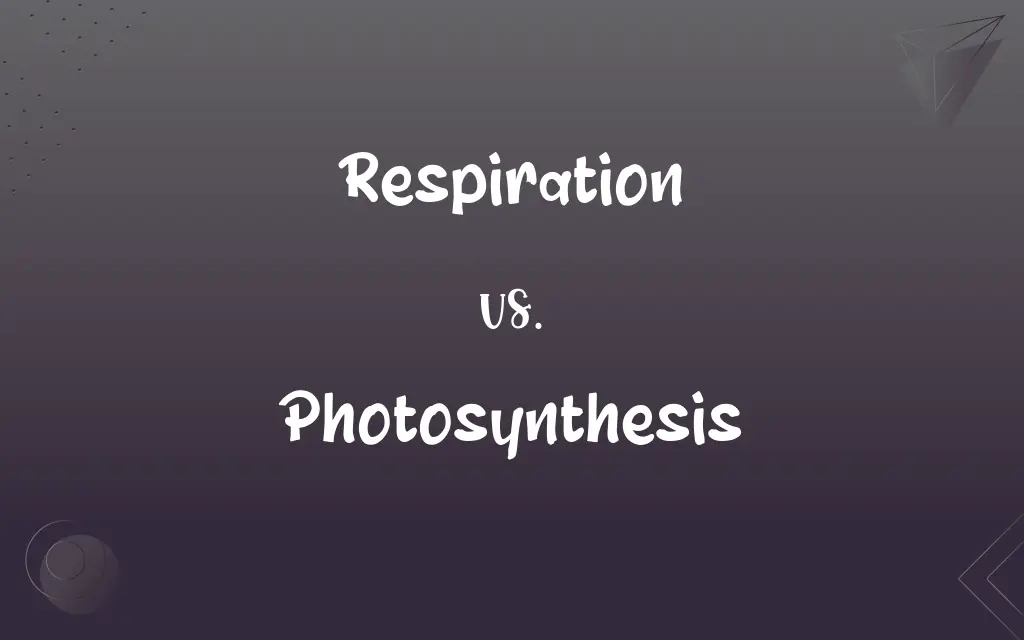Respiration vs. Photosynthesis: What's the Difference?
Edited by Aimie Carlson || By Harlon Moss || Updated on October 12, 2023
Respiration refers to cellular process converting O2 to CO2, releasing energy. Photosynthesis refers to plants convert light energy, CO2, and H2O into glucose and O2.

Key Differences
Respiration is a cellular activity that happens in every living cell, wherein they intake oxygen and give out carbon dioxide, releasing energy. Photosynthesis is a contrasting yet complimentary process, majorly occurring in plants, which takes in carbon dioxide and releases oxygen, utilizing light energy to form glucose.
The key aspect of respiration is to produce energy by breaking down glucose and other metabolites, emitting carbon dioxide as a byproduct. In photosynthesis, plants use sunlight to convert carbon dioxide and water into glucose, a type of sugar that provides energy to the plant, releasing oxygen as a side product.
When considering the site of occurrence, respiration predominantly takes place in the mitochondria of cells. On the other hand, photosynthesis happens primarily in the chloroplasts of plant cells, utilizing the chlorophyll pigment to capture sunlight.
Remarkably, respiration and photosynthesis interlink in a way where the output of one process becomes the input for the other, maintaining a balance in the ecosystem. While respiration exhales carbon dioxide, photosynthesis consumes it, and conversely, photosynthesis exhales oxygen which is used by organisms for respiration.
Through respiration, organisms utilize oxygen to facilitate their metabolic activities and sustain life. Photosynthesis ensures the continual availability of this vital oxygen, allowing life to thrive, while also aiding in energy transfer through ecosystems by forming glucose which serves as a primary energy source for many organisms.
ADVERTISEMENT
Comparison Chart
Goal
Produces energy (ATP)
Produces glucose
Occurs in
All living cells
Mostly plants (in chloroplasts)
Main Process
Oxidation of glucose
Reduction of carbon dioxide
Gas Used
Oxygen (O2)
Carbon dioxide (CO2)
Gas Produced
Carbon dioxide (CO2)
Oxygen (O2)
ADVERTISEMENT
Respiration and Photosynthesis Definitions
Respiration
Respiration also denotes cellular activity converting nutrients into energy.
Cellular respiration provides energy to the cells to perform functions.
Photosynthesis
Photosynthesis utilizes water, carbon dioxide, and sunlight, mainly in plants.
Plants absorb water and carbon dioxide to perform photosynthesis.
Respiration
In physiology, respiration involves exchanging gases with the environment.
Through respiration, oxygen enters and carbon dioxide exits our body.
Photosynthesis
Photosynthesis is the process through which plants create their own food.
Photosynthesis enables plants to produce oxygen as a byproduct.
Respiration
Respiration refers to the process of breathing.
He paused to catch his respiration after the rigorous exercise.
Photosynthesis
Photosynthesis occurs in the chloroplasts, utilizing chlorophyll.
Chlorophyll captures sunlight to perform photosynthesis in the leaves.
Respiration
Respiration can imply the mechanism enabling aerobic organisms to survive.
Respiration in humans involves lungs to facilitate air intake and expulsion.
Photosynthesis
Photosynthesis plays a crucial role in oxygen production for our planet.
Oxygen available in our atmosphere is primarily due to photosynthesis.
Respiration
In a broad sense, respiration elucidates an organism’s energy production method.
Plant respiration takes place throughout the day and night, utilizing stored energy.
Photosynthesis
Photosynthesis involves the conversion of light energy into chemical energy.
Through photosynthesis, sunlight is utilized to generate glucose.
Respiration
The action or process of inhaling and exhaling; breathing. Also called ventilation.
Photosynthesis
The process in green plants and certain other organisms by which carbohydrates are synthesized from carbon dioxide and a source of hydrogen (usually water), using light as an energy source. Most forms of photosynthesis release oxygen as a byproduct.
Respiration
An act of inhaling and exhaling; a breath.
FAQs
Where in the plant does photosynthesis mainly occur?
Photosynthesis mainly occurs in the leaves of a plant, specifically in the chloroplasts.
What is the chemical equation for respiration?
The chemical equation for respiration is C6H12O6 + 6O2 → 6CO2 + 6H2O + energy (ATP).
Where does respiration take place in the cell?
Respiration primarily occurs in the mitochondria of the cell.
What is respiration?
Respiration is a biochemical process in cells that converts nutrients into energy, using oxygen and producing carbon dioxide.
How does the process of photosynthesis impact the environment?
Photosynthesis reduces carbon dioxide levels, produces oxygen, and helps in forming the basis of food chains in ecosystems.
What role does chlorophyll play in photosynthesis?
Chlorophyll absorbs light energy, which drives the reactions in photosynthesis.
How does photosynthesis work?
Photosynthesis uses sunlight to convert carbon dioxide and water into glucose and oxygen in the chloroplasts of plant cells.
What is the chemical equation for photosynthesis?
The chemical equation for photosynthesis is 6CO2 + 6H2O + light energy → C6H12O6 + 6O2.
Why is photosynthesis important for life on Earth?
Photosynthesis produces oxygen, essential for aerobic life, and generates glucose, providing energy for organisms.
Why is respiration crucial for living organisms?
Respiration is vital for producing the energy required for cells to carry out their functions.
Which organisms undergo photosynthesis?
Photosynthesis is typically found in plants, algae, and certain bacteria like cyanobacteria.
What are the end products of respiration?
The end products of respiration are carbon dioxide, water, and energy in the form of ATP.
Can photosynthesis occur without sunlight?
No, photosynthesis requires sunlight to convert carbon dioxide and water into glucose and oxygen.
Is respiration a daytime or nighttime process?
Respiration in cells occurs continuously, both during the day and night.
Do animals participate in the process of photosynthesis?
No, animals do not perform photosynthesis; they rely on respiration to gain energy.
What are the end products of photosynthesis?
The end products of photosynthesis are glucose and oxygen.
Can respiration occur in plants?
Yes, plants undergo respiration to generate energy, especially during the absence of sunlight.
Is water required for respiration?
Yes, water is a byproduct of cellular respiration and is also used in some metabolic pathways.
Can photosynthesis happen in artificial light?
Yes, photosynthesis can occur under artificial light if the light spectrum mimics that of sunlight.
Are respiration and photosynthesis related?
Yes, they are inversely related as respiration consumes oxygen and produces carbon dioxide, while photosynthesis consumes carbon dioxide and produces oxygen.
About Author
Written by
Harlon MossHarlon is a seasoned quality moderator and accomplished content writer for Difference Wiki. An alumnus of the prestigious University of California, he earned his degree in Computer Science. Leveraging his academic background, Harlon brings a meticulous and informed perspective to his work, ensuring content accuracy and excellence.
Edited by
Aimie CarlsonAimie Carlson, holding a master's degree in English literature, is a fervent English language enthusiast. She lends her writing talents to Difference Wiki, a prominent website that specializes in comparisons, offering readers insightful analyses that both captivate and inform.
































































